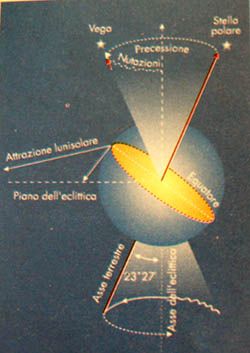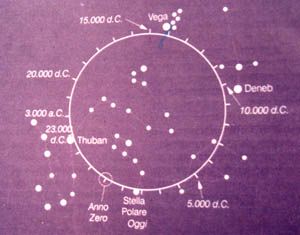The motions of the earth are many. What we have already discussed the motion of rotation, which is what makes the earth turning on itself in 24 hours, and the motion of revolution, namely that the earth takes around the sun. Besides these two there are others much more complex and occurring at considerable speed: one is that of our solar system that revolves around the center of the Galaxy (in the order of hundreds of kilometers per second) called motorcycle travel, and another is that of our galaxy that moves within the Universe.
Other motions that take place in times longer than the rotation and revolution, the so-called motions millennia, they are minor compared to the other, and occur in a longer period of time, millennia in fact. The first millennium
motion (mm) is called "precession of the equinoxes" that I have already mentioned. It 's the most powerful known mm long, think that if they had already noticed the Egyptian astronomers, when they noticed that the moment of the vernal equinox calculated by calendar year, each year differed from that calculated with the formula of 20 minutes with' sidereal year. The cause of precession is given by the gravitational pull that the moon and sun exert along the equator of the earth, tend to "straighten" the Earth's axis (which is tilted about 23 ° from vertical on the ecliptic). The Earth, however, opposes luni-solar attraction, and the result of this "tug" is that the Earth's axis every 25,000 years describes a double cone (see fig.) With the top center of the earth. This movement is from east to west, and then reverse the motion of the Earth's rotation, and is called retrograde motion.

The consequences of the precession of the equinoxes are different: first of all is that the Earth's axis will always point not like now to the Pole Star, in fact in about 13,000 years it will point towards the star Vega , in the constellation Lyra.

Furthermore, because of this movement, even horoscope constellations have changed their position . Compared to the fourth century BC, when the constellations were fisate, the motion of precession of the Earth was undertaken over a period of 40 °. So the vernal equinox the sun is already in fish, and spends in the air after April 21.
A further consequence is that the seasons are anticipated each year a little bit. When the Earth's axis will have completed half of his round, the seasons are reversed. Mm The second is that of nutations . They are made of small vibrations Earth's axis and along the double cone mentioned above. The case is the same, the luni-solar attraction. (See fig.)
The third is the mm displacement of the line of apses. line of apses, as we have said, the union line between the aphelion and perihelion. This line shifts of 11 "of arc per year, taking place under the direction of movement of the earth (called direct drive), and" meets "the precession of the equinoxes. So the motion of precession is reduced from 25,000 to 21,000 years and we can also calculate that between 4500 years and that the line of apses of the equinoxes will be superimposed.
The fourth movement is the millennial variation of the eccentricity of the orbit land. The variation of the eccentricity of the orbit implies a greater or lesser closeness between earth and sun, and therefore gives variations on the amount of solar radiation received on earth. The fifth and final
mm is the difference in the inclination of the Earth's . As we know, it is tilted by 23 ° 27 'with respect to the vertical and in 40,000 years, the slope varies from a minimum of 21 ° 58' to a maximum of 24 ° 36 '. This affects the climate in different stragioni, because the inclination of the Earth depends on the angle of incidence of sunlight on Earth if the sun will come on earth perpendicularly warmer vice versa if they are more inclined the amount of solar radiation will be smaller, and therefore will relatively cold.
And the next time you start with the solar system:) It's called